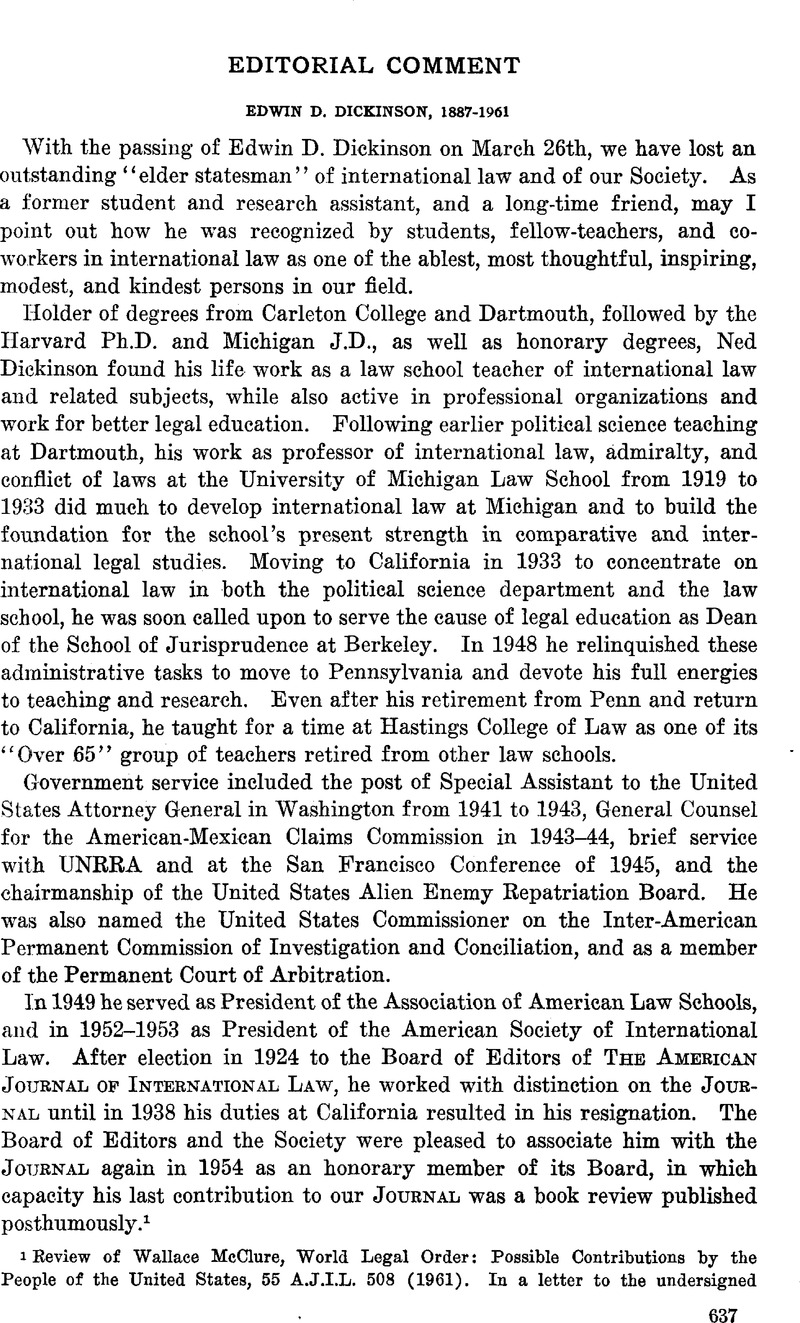No CrossRef data available.
Published online by Cambridge University Press: 28 March 2017

1 Review of Wallace McClure, World Legal Order : Possible Contributions by the People of the United States, 55 A.J.I.L. 508 (1961). In a letter to the undersigned written on the day of his sudden death, Ned Dickinson expressed his interest in preparing for the JOURNAL an article on “acts of state.”
2 Dickinson, The Equality of States in International Law viii-ix (1920).
3 Dickinson, , “The Teaching of International Law to Law Students,” 17 Am. Pol. Sci. Rev. 464, 473 (1923)CrossRefGoogle Scholar.
4 McGraw-Hill, 1929. Reviewed by Fenwiek, 23 A.J.I.L. 891 (1929).
5 Foundation Press, 1950. Reviewed by Woolsey, 45 A.J.I.L. 607 (1951).
6 1949 Handbook of Association of American Law Schools 45, at 53.
7 Published in 29 A.J.I.L. Supp. 435-651 (1935).
8 Cf. Oliver, , “The American Law Institute ‘s Draft Restatement of the Foreign Relations Law of the United States,” 55 A.J.I.L. 428, 432 (1961)Google Scholar.
9 In the preface to the 1919-22 volume of the Annual Digest, Dr. Hersch Lauterpacht and Sir John Fischer Williams acknowledged Dickinson’s participation as a “capital contribution of essential importance to the usefulness of the present volume.” (p. ix.)
10 See Dickinson’s articles or books: “The United States and World Organization,” 16 Am. Pol. Sci. Rev. 183 (1922); “New Law of Nations,” 32 W. Va. Law Q. 4 (1925); “The Law of Change in International Relations,” 11 Proceedings of the Institute of World Affairs 173 (1933); “International Law: An Inventory,” 33 Calif. Law Rev. 506 (1945); What Is Wrong with International Law? (pamphlet, 1947); Law and Peace (1951).
11 The Equality of States in International Law (1920).
12 “The Unrecognized Government or State in English and American Law,” 22 Michigan Law Rev. 29, 118 (1923); “Recent Recognition Cases,” 19 A.J.I.L. 263 (1925); “Recognition Cases 1925-1930,” 25 A.J.I.L. 214 (1931); “Recognition of Russia,” 30 Mich. Law Rev. 181 (1931).
13 “Is the Crime of Piracy Obsolete?”, 38 Harv. Law Rev. 334 (1925); “Jurisdiction at the Maritime Frontier,” 40 ibid. 1 (1926); “Treaties for the Prevention of Smuggling,” 20 A.J.I.L. 340 (1926); “Are the Liquor Treaties Self-Executing?” ibid. 444; “The Supreme Court Interprets the Liquor Treaties,” 21 ibid. 505 (1927), and 27 ibid. 305 (1933).
14 Harvard Research in International Law, Jurisdiction with Respect to Crime, loc. cit. note 7 above; “The Blackmer Case,” 26 A.J.LL. 351 (1932); “Jurisdiction Following Seizure or Arrest in Violation of International Law,” 28 ibid. 231 (1934).
15 “International Political Questions in the National Courts,” 19 A.J.I.L. 157 (1925); “Changing Concepts and the Doctrine of Incorporation,” 26 ibid. 239 (1932); The Interpretation and Application of International Law in Anglo-American Countries (1932, privately printed; substantially the same as his Hague Academy of International Law lectures on “L’interpretation et l’application du droit international dans les pays anglo-américains,” 40 Recueil des Cours 305 (1932, II) ; “The Law of Nations as Part of the National Law of the United States,” 101 U. Pa. Law Rev. 26, 792 (1952, 1953); “The Law of Nations as National Law: Political Questions,” 104 ibid. 451 (1956).
16 “Domicil of Persons Residing Abroad under Consular Jurisdiction,” 17 Mich. Law Rev. 437, 694 (1919).
17 “The Lusitania—Destruction of Enemy Merchant Ships without Warning,” 17 Mich. Law Rev. 167 (1918); “Enemy Alien Litigants in the English Law,” ibid. 596 (1919); “Execution of Peace with Germany: An Experiment in International Organization,” 18 ibid. 484 (1920); “Neutrality and the Munitions Traffic,” 1935 A.S.I.L. Proceedings 45; “The Neutrality of the United States,” 1937 111. S.B.A. 17.
18 “Closure of Ports in Control of Insurgents,” 24 A.J.I.L. 69 (1930).
19 “The Meaning of Nationality in the Recent Immigration Acts,” 19 ibid. 344 (1925).
20 “Defamation of Foreign Governments,” 22 ibid. 840 (1928).
21 “Waiver of State Immunity,” 19 ibid. 555 (1925); “The Immunity of Public Ships Employed in Trade,” 21 ibid. 108 (1927).
22 See his mimeographed casebook on Admiralty (1924) ; Dickinson and Andrews, “A Decade of Admiralty in the Supreme Court of the United States,” 36 Calif. Law Rev. 169 (1948).
23 See, for example, “Gratuitous Partial Assignments,” 31 Yale Law J. 1 (1921).
24 “The Analogy between Natural Persons and International Persons in the Law of Nations,” 26 Yale Law J. 564 (1917).
25 Published in 1920 as an expansion of his Ph.D. dissertation at Harvard under G. G. Wilson.
26 op. cit. 335.
27 Ibid. 336.
28 “The Law of Change in International Relations,” 11 Proceedings of the Institute of World Affairs 173, 177 (1933).
29 What Is Wrong with International Law?, 7th Bernard Moses Memorial Lecture, May 22, 1946. This was largely based on Dickinson, “International Law: An Inventory,” 33 Calif. Law Rev. 506 (1945).
30 Published as Law and Peace (1951).
31 Op. cit. 119-120.
32 Ibid. 127.
33 Ibid. 132-133.
34 Ibid. 143.
35 1953 A.S.I.L. Proceedings 5-6.
36 Ibid. 3.
37 Ibid. 7.